Auctions
Sotheby’s Livestreamed Paris-to-London Hybrid Sale Pulled in $90 Million, Led by a Picasso and Banksy’s Irreverent Twist on Monet
Observers describe it as "painting by numbers" auction action.
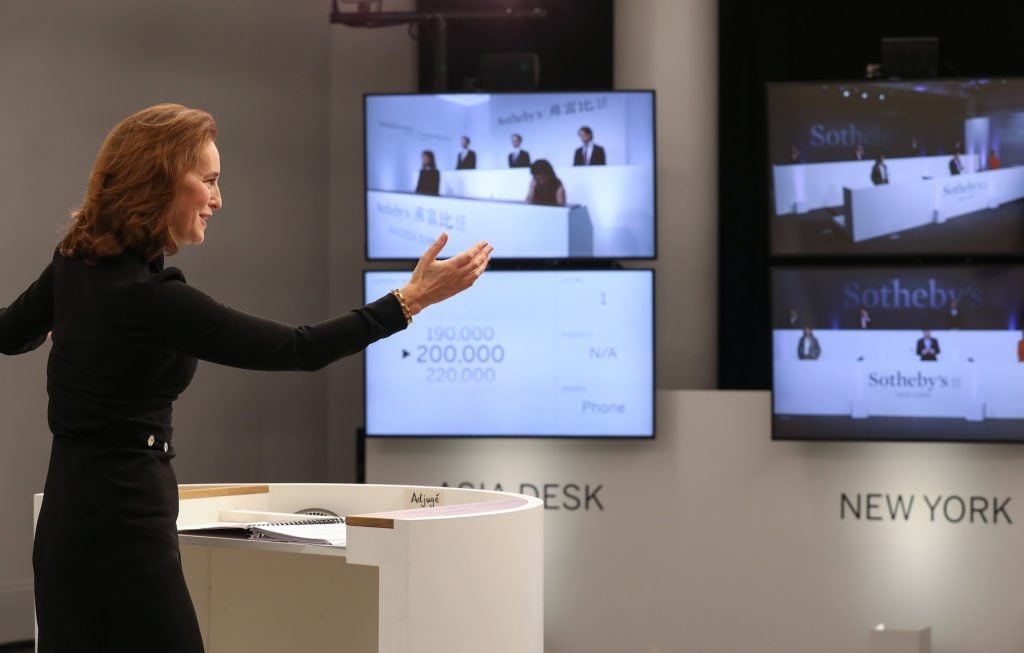
Observers describe it as "painting by numbers" auction action.

Eileen Kinsella

As auction houses continue to forge ahead with hybrid physical and digital auctions amid travel restrictions, they are putting serious time, effort, and money into hyped-up, seamless live-streamed sales. Today’s effort by Sotheby’s, which started with a sale of Modern art in Paris before moving on to a second offering of contemporary art in London, illustrates both the successes and the pitfalls of this model.
On the one hand, auctioneers Helena Newman and Oliver Barker pulled off an incredible feat by manning the rostrum with a bank of screens in front of them, keeping the momentum up as they fielded bids from specialists on desks in New York, London, Paris, and Asia. They also had to keep track of online bids, of which the number seems to be on the rise, fittingly enough in our increasingly remote world. There were numerous, serious prices realized, including bidding wars between two online bidders and several instances where an online bidder was the winner of an artwork. (Barker narrated the online action out loud to those observing, punctuated occasionally with lines like “it truly is the future!” for color—otherwise it would just be silence with no visual cues.)
On the other hand, Newman, who helmed the Paris sale, was bouncing back and forth between English and French seemingly at random, which felt disruptive to the flow of the proceedings at times. And communication with specialists in four different venues also proved challenging, particularly when it was obvious someone was not sure whether, or at what price, they had the bid. (“I took [the bid] from London. I will sort out Paris,” Newman said at one confusing point during bidding on a major Paul Klee painting.)
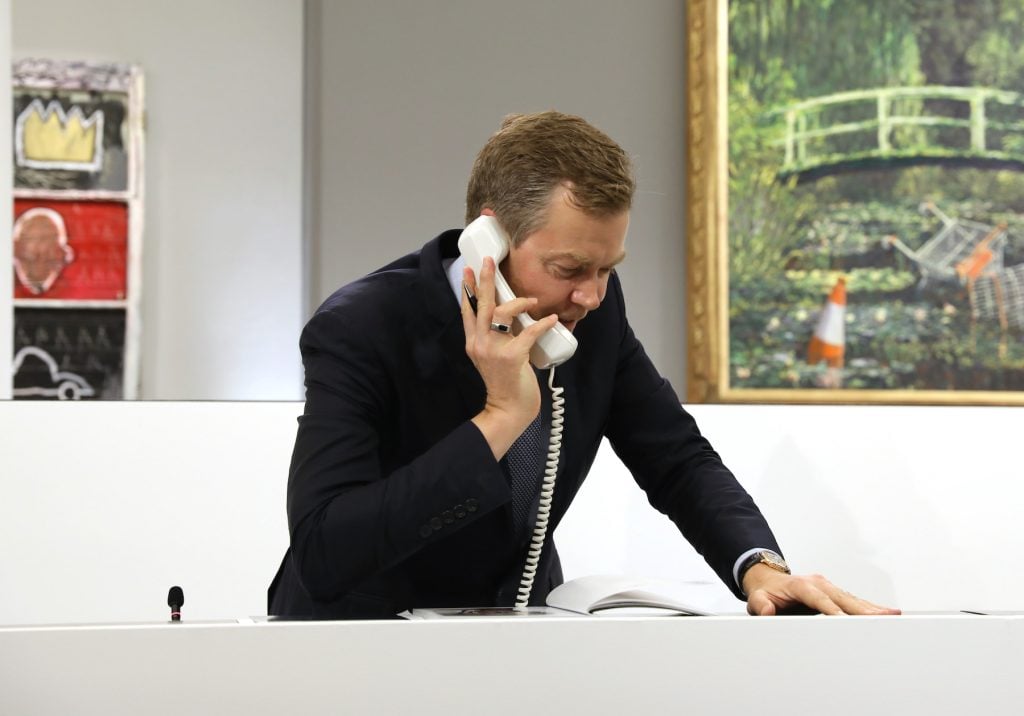
Oliver Barker at Sotheby’s on October 21, 2020 in London, England. (Photo by Tristan Fewings/Getty Images for Sotheby’s)
The currency switched from euros to British pounds when Barker took the helm for the London sale. Each of the Modern and contemporary portions featured just under 50 lots (49 lots in modern and 48 in contemporary). Notably, each sale had withdrawn lots announced immediately before the sale.
For Modern, it was four lots; for contemporary, it was six. Those numbers marked an uptick from the usual one or two withdrawals that tend to be announced at the start of a marquee evening sale, indicating jitters on the part of consignors. Bidding at the contemporary sale in particular seemed highly selective, with few works sparking bidding wars and many selling below or near the low end of the estimate.
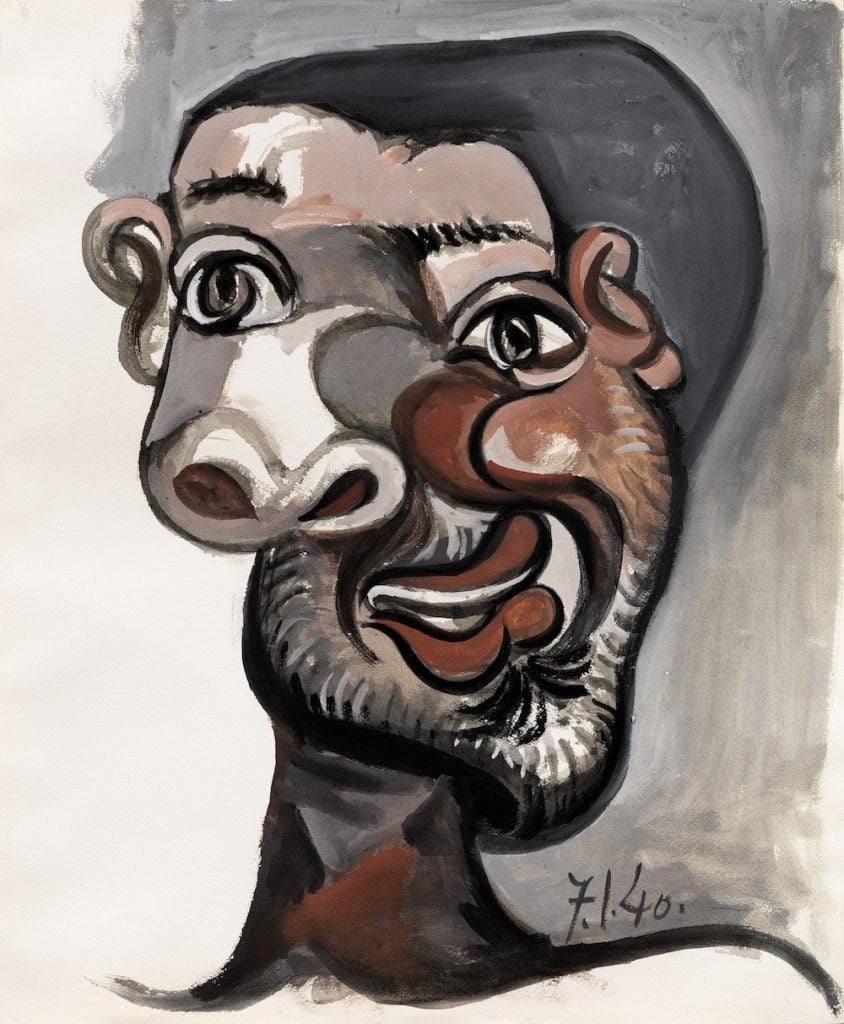
Pablo Picasso, Tête d’homme (1940). Image courtesy Sotheby’s.
A total of 24 of the modern lots were guaranteed (six of these were third-party or outside backers), while eight of the lots in the contemporary sale were guaranteed (half were third-party).
Prior to the withdrawal announcements, overall presale expectations were $93.5 million to $131.9 million, with Modern estimated at $25.8 million to $36.7 million and the contemporary at $67.6 million to $95.2 million.
Modern was revised down to $25.4 million to $35.9 million, and the sale made $28.2 million. On a hammer basis, the sale made an under-estimate $23 million. Of 45 lots on offer, 36, or 80 percent, sold.
Contemporary was revised down to $55 million to $78.2 million to reflect the withdrawals. The sale pulled in $62.2 million, considerably below the original low estimate and in the middle of the revised range. Of 41 lots offered, 34, or 83 percent, were sold. On a hammer basis, it pulled in $51.4 million.
At the Modern sale in Paris, the top lot was Picasso’s Tête d’Homme (1940), which had a third-party guarantee and sold for €4.4 million ($5.2 million) or €3.7 million ($4.7 million) hammer, likely to the third-party guarantor.
Francis Picabia’s Minos (1929), with multiple layers of overlapping imagery, incited a mini-bidding war. Bidding opened at €2.2 million ($2.6 million) and it was chased up to €3.3 million ($3.9 million) before it was hammered down to Sotheby’s chairman of contemporary art Europe, Claudia Dweck, bidding for a client. The final price with premium was €3.95 million ($4.7 million).
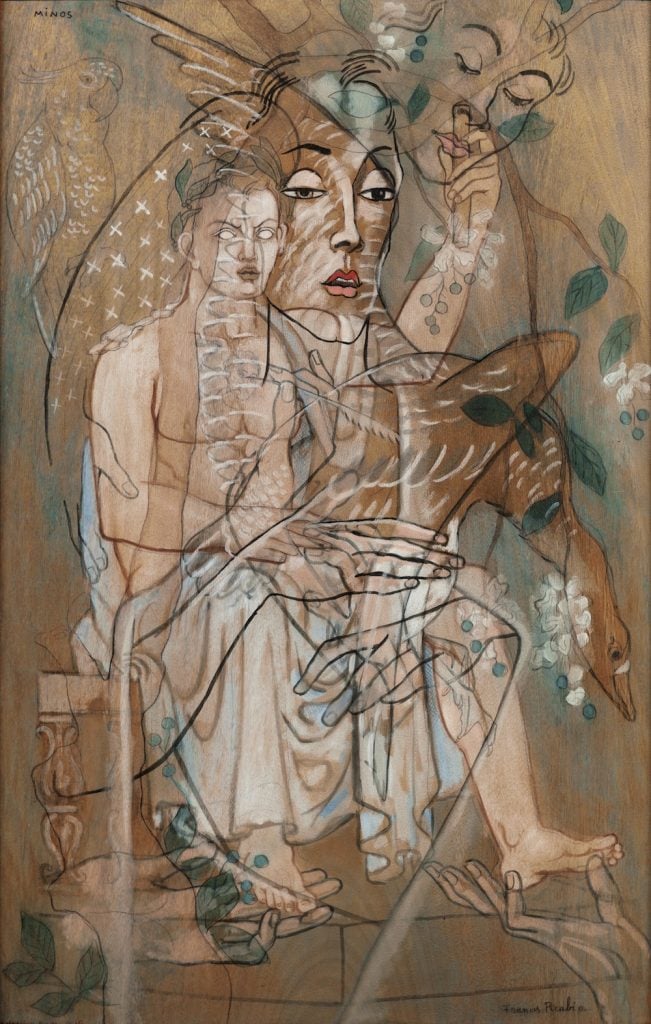
Francis Picabia, Minos (circa 1929). Image courtesy Sotheby’s.
The third-highest lot, a painting by Gutai artist Kazuo Shiraga, Chikaisei Shinsanshi (1961), went to Sotheby’s specialist Ei-Linn Liew on the Asia desk for €2.55 million ($3 million), on behalf of a client.
Another instance where technical difficulties—in the form of a last-minute bid showing up with a slight delay on the screen in front of the auctioneer—came during the final moments of bidding for a Pierre Soulages painting, Peinture 73 X 60 cm, 15 Septembre 1975 (1975). As Newman was about to hammer down the work at €560,000, another bid rolled in for €580,000. “We saw you,” said Newman, who emphasized the rule of a bid being okay if it comes in “on the hammer.” She reopened the action, but the determined bidder who previously had it regained control with a bid of €600,000—and won it for a premium-inclusive €738,500 ($871,600).

Banksy, Show Me The Monet (2005). Image courtesy Sotheby’s.
The London contemporary sale was led by Banksy’s cheeky Show Me The Monet (2005), a scene depicting a bridge at Claude Monet’s famous garden in Giverny, rendered in the Impressionist master’s indelible strokes, but with detritus including a discarded bright orange modern-day traffic cone and an overturned shopping basket bobbing in the water below. It sold for £7.5 million ($9.8 million) after it was chased by more than five bidders, including a new bid at £5.7 million by one specialist whose client went head to head with a client of Sotheby’s chairman of Asia, Patti Wong. Ultimately Wong’s client won it for a hammer bid of £6.4 million ($8.2 million).
The price marks the second-highest at auction for Banksy, following the £9.8 million ($12.2 million) achieved at Sotheby’s London last October for Devolved Parliament (2009), a painting showing UK government being run by monkeys.
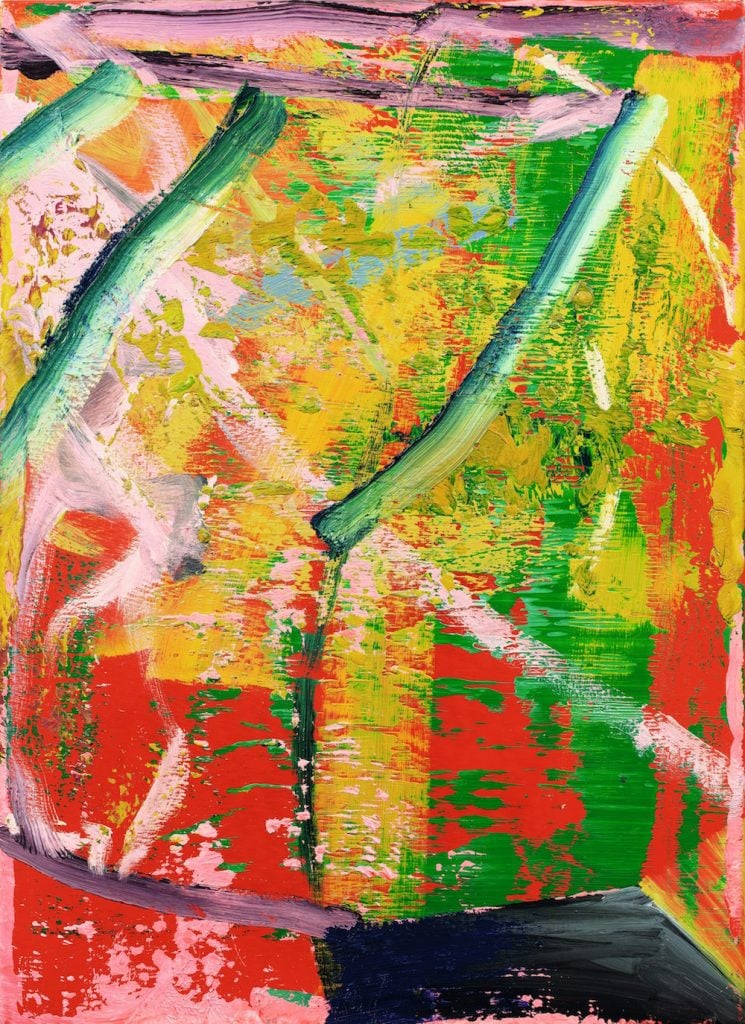
Gerhard Richter, Arnold (1983). Image courtesy Sotheby’s.
A Gerhard Richter abstract painting from 1991 was the second-priciest lot, at £5 million ($6.7 million), also selling to a client of Wong’s. And a Jean-Michel Basquiat work, Justcome Suit (1993), sold for £5.07 million ($6.6 million) to Sotheby’s senior vice president and head of the contemporary department in New York, Grégoire Billault.
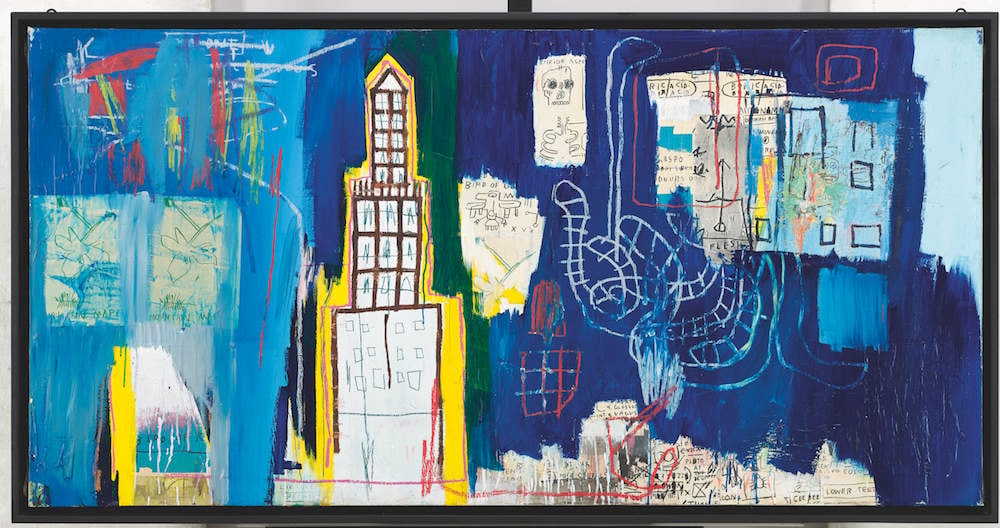
Jean-Michel Basquiat, Justcome Suit (1983). Image courtesy Sotheby’s.
Another top lot was Adrian Ghenie’s Pie Fight Interior (2012), which sold for £2.8 million ($3.7 million) to a Sotheby’s specialist bidding for a client. Barker appeared openly surprised when the bids reached only as high as £2.4 million, a single bid higher than where he opened the sale. He resigned himself to the fact that no more competition was forthcoming and hammered it down.
Among the bought in or unsold works were pieces by Albert Oehlen, Rudolf Stingel, and Georg Baselitz. Perhaps more surprising were the unsold works by current market darlings Yayoi Kusama and Cecily Brown, along with a mixed-media work by Maurizio Cattelan.
The auction houses “have done pretty well, actually,” considering the challenging circumstances, said one former auction expert turned private dealer. The problem is that “the market is immensely depressing. It’s almost painting by numbers… it’s, ‘We’re going to have a Banksy, now we’re gonna have a Kusama, now we’re going to have an Adrian Ghenie. The first four lots are going to be whatever the hottest artists at the moment are—but when they come to try to re-sell it, good luck to them.”
Not that such a formula is anything new. “But it’s become more extreme,” the person said. “There’s no connection that potential buyers can have with the art standing in front of it, seeing the surface, or the background or having a conversation with a specialist. It’s hard to get excited about the work.”
On the other hand, the dealer notes, auction houses are still selling millions of dollars worth of art at a time when catalogue printing costs have been cut to near zero and travel costs are at a minimum. So it’s likely that they’re doing quite well, all told.